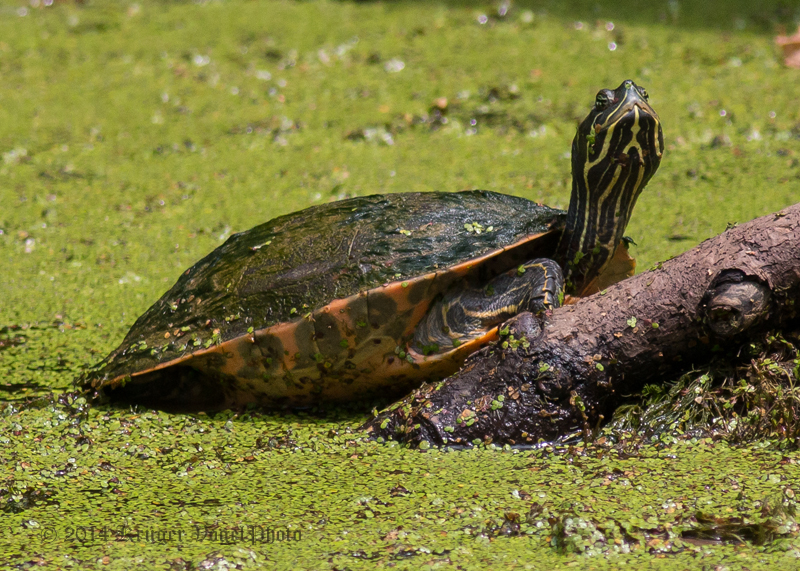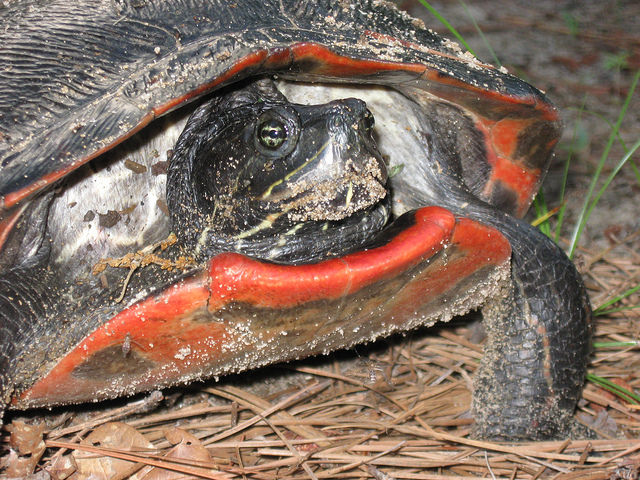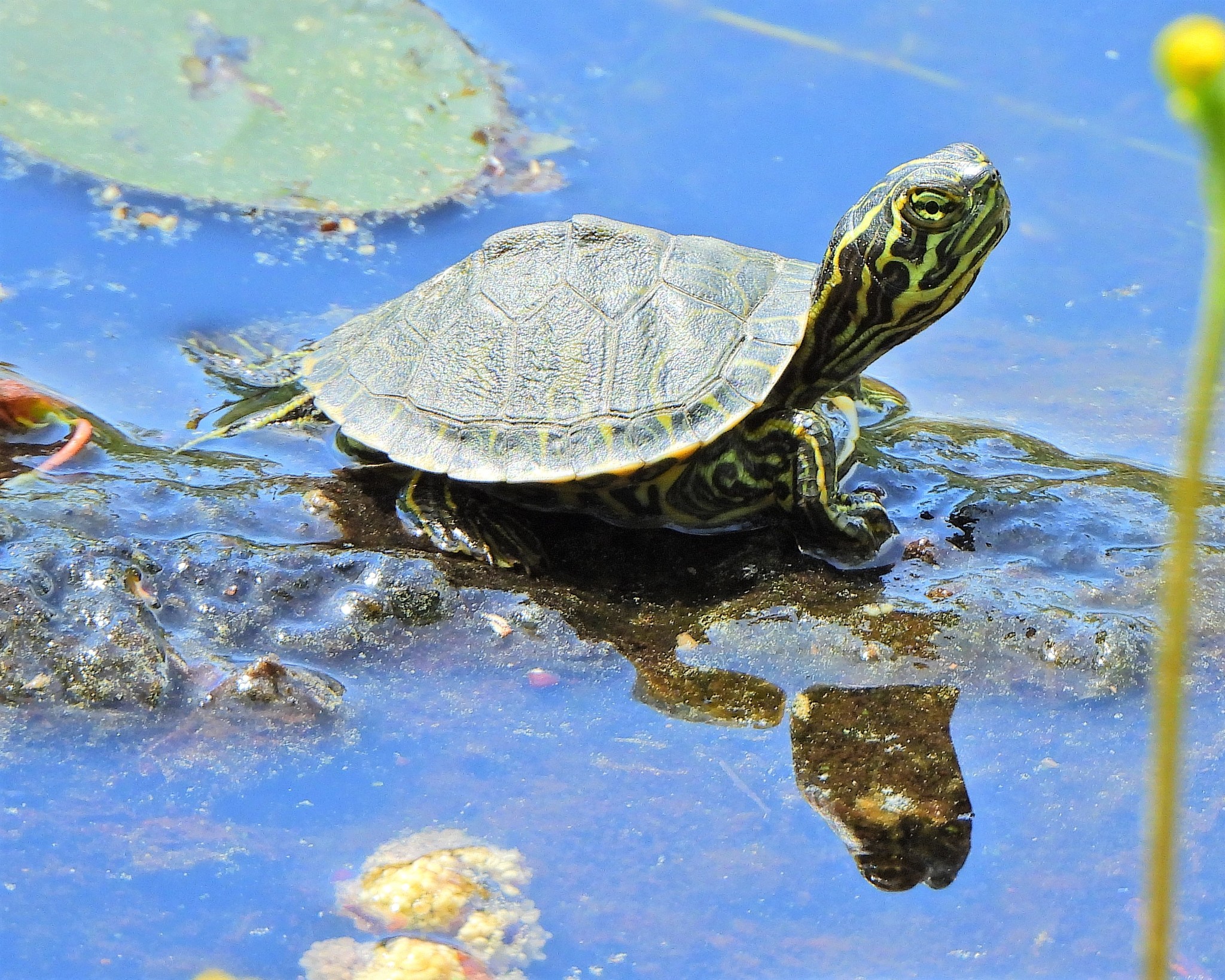Map Snapshot

























976 Records
Status
Northern Red-bellied Turtle (Pseudemys rubriventris) is a large species of aquatic turtle, well known for conspicuous basking behavior. Large individuals can be distinctive compared to the much smaller Eastern Painted Turtle, which is often seen basking at the same time. Northern Red-bellied Turtles are generally fond of rivers, ponds, and lakes, and generally larger, deeper bodies of water, with dense vegetation and sites for basking. This species will tolerate brackish water, and can be found in estuarine environments (Conant & Collins, 1998; Maryland DNR site). This species is distributed across much of the state, but especially on the coastal plain, and ranging west to Allegany Co. (Maryland DNR site).
Seasonality Snapshot
Source: Wikipedia
| Northern red-bellied cooter | |
|---|---|

| |
| Scientific classification | |
| Domain: | Eukaryota |
| Kingdom: | Animalia |
| Phylum: | Chordata |
| Class: | Reptilia |
| Order: | Testudines |
| Suborder: | Cryptodira |
| Superfamily: | Testudinoidea |
| Family: | Emydidae |
| Genus: | Pseudemys |
| Species: | P. rubriventris
|
| Binomial name | |
| Pseudemys rubriventris | |
| Synonyms[3] | |
| |
The northern red-bellied turtle (Pseudemys rubriventris)[2] or American red-bellied turtle is a species of turtle in the Pseudemys (cooter) genus of the family Emydidae.
Description
[edit]This is a fairly large river turtle. Females average about 30 cm (12 in) in length and weigh on average around 3 kg (6.6 lb), although large females can measure up to 40 cm (16 in).[1] Males' maximum size is 29.5 centimetres (11.6 in).[1] The northern red-bellied turtle is the largest recorded basking turtle in the Chesapeake Bay region.[4]
Distribution and habitat
[edit]It is endemic to the United States. The current range of the red-bellied turtle includes a population in Massachusetts, the Plymouth red-bellied turtle, which was previously considered a distinct subspecies (Pseudemys rubriventris bangsi) as well as the coastal areas of New Jersey, Pennsylvania, Delaware, Maryland, Virginia and North Carolina.

The red-bellied turtle has appeared on Pennsylvania Fish and Boat Commission lists of endangered amphibians and reptiles since 1978 (McCoy 1985). By 1985 the red-bellied turtle was known to exist in Pennsylvania only in isolated colonies in a few counties (McCoy 1985). Small (less than thirty individuals) colonies were known in Manor and Silver lakes in Bucks County, the Tinicum wetlands in Philadelphia and Delaware Counties, the West Branch of Conococheague Creek in Franklin County and possibly Springton Reservoir in Delaware County (McCoy 1985).
Conservation
[edit]The red-bellied turtle is a threatened[5] species within Pennsylvania. However, the Plymouth red-bellied turtle distinct population segment is listed as endangered by the US Fish and Wildlife Service[6] as well as the Division of Fisheries and Wildlife (Massachusetts).[7]
The potential threats to red-bellied turtle populations are numerous. Primary threats include wetland loss, habitat fragmentation, pollution, collecting of turtles for pets, food or other trophies, competition with the invasive red-eared slider turtle (Trachemys scripta elegans) for food, habitat, basking sites or nesting sites, and the potential for hybridization with red-eared slider turtles.
The Massachusetts wildlife preserve foundation has started to repopulate the turtles by placing them in many southeastern Massachusetts ponds.[8] One example is at Long and Little Long Pond in Plymouth, Massachusetts, where the population is starting to regrow.[citation needed]
References
[edit]- ^ a b c van Dijk, P.P. (2016) [errata version of 2011 assessment]. "Pseudemys rubriventris". IUCN Red List of Threatened Species. 2011: e.T18460A97427406. doi:10.2305/IUCN.UK.2011-1.RLTS.T18460A8299690.en. Retrieved 25 July 2024.
- ^ a b Rhodin 2010, p. 000.102
- ^ Fritz Uwe; Peter Havaš (2007). "Checklist of Chelonians of the World". Vertebrate Zoology. 57 (2): 195–196. doi:10.3897/vz.57.e30895.
- ^ "Red-bellied Cooter". Chesapeake Bay. Retrieved 2024-04-01.
- ^ "58 Pa. Code § 75.2 Threatened species". Pennsylvania Code. Commonwealth of Pennsylvania. 22 April 2023. Retrieved 15 July 2023.
- ^ "Plymouth Redbelly Turtle (Pseudemys rubriventris bangsi)". Environmental Conservation Online System. U.S. Fish & Wildlife Service. Retrieved 15 July 2023.
- ^ "Amphibians and Reptiles in Massachusetts". mass.gov. Commonwealth of Massachusetts. 2023. Retrieved 15 July 2023.
- ^ Massachusetts Divisions of Fisheries and Wildlife (2019). "Northern Red-bellied Cooter". Massachusetts Divisions of Fisheries and Wildlife. Retrieved April 1, 2024.
- Tortoise & Freshwater Turtle Specialist Group 1996. Pseudemys rubriventris. 2006 IUCN Red List of Threatened Species. Downloaded on 29 July 2007.
- Article title
- https://web.archive.org/web/20070824020806/http://www.dgif.state.va.us/wildlife/species/display.asp?id=030057
- McCoy, C. J. 1985. Species of Special Concern in Pennsylvania, in H. H. Genoways and F. J. Brenner, editors. Special Publication of Carnegie Museum of Natural Pennsylvania. Carnegie Museum of Natural History, Pittsburgh, PA.
- http://www.mass.gov/eea/docs/dfg/nhesp/species-and-conservation/nhfacts/pseudemys-rubriventris.pdf
- Bibliography
- Rhodin, Anders G.J.; van Dijk, Peter Paul; Inverson, John B.; Shaffer, H. Bradley (2010-12-14). "Turtles of the World 2010 Update: Annotated Checklist of Taxonomy, Synonymy, Distribution and Conservation Status" (PDF). Archived from the original (PDF) on 2011-07-17.







































